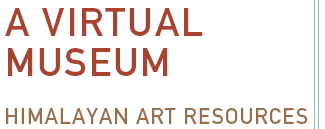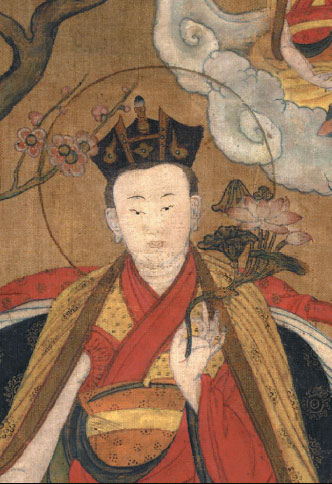 |
By Barry Boyce |
|
|
Summer 2005 > Profile |
|
In 1997, Shelley and Donald Rubin, longtime collectors
of Himalayan art, decided it was time to make more of this richly detailed
and largely sacred art available on the Internet. Under the sponsorship
of the Shelley and Donald Rubin Foundation, their efforts blossomed
into Himalayan Art Resources, which maintains an ever-growing website
of encyclopedic scope. The site, himalayanart.org, is a boon not only
to art scholars and enthusiasts, but also to practitioners and students
of Vajrayana Buddhism, who can view hundreds of sacred images accompanied
by precisely detailed descriptions of their iconography.
The nearly twenty thousand images of sculptures, ritual objects, paintings, and textiles on the site are not limited to Buddhist works. The Hindu and Bon traditions are also richly represented. Director Jeff Watt (who is also curator of the Rubin Museum of Art) and a small staff have pulled together images from almost eighty different sources, including private collections, photographic archives, published works, and nearly forty museums in North America, Europe, and Asia. Watt and his team have been able to forge relationships with numerous institutions, he says, because "in many cases these institutions do not have the time or expertise to catalog their collections."
If any site could claim to be a virtual museum, it is himalayanart.org. One can browse for hours through gallery after gallery of images, pulling them up from a long list, tunneling down and zooming in to the point where the palm of a buddha's hand takes up the whole screen. For Watt, however, offering a dazzling online art show is a small part of the story. "When this art was first looked at and collected in the West," he told me in his Manhattan office, "its meanings and context were not well understood." Pointing to shelves and piles of books of Himalayan art, he explained, "Most of the descriptions in these works are ninety percent wrong. People just did not know what they were looking at and they made very bad guesses."
Watt began practicing under the late Deshung Rinpoche over thirty years ago and has spent many years in retreat. When the Rubins called on him in early 1998, he had been translating liturgies and commentaries for practitioners and keeping up a website that included iconographical descriptions. Watt felt the foundation's work provided an opportunity to promote Himalayan art, which he emphasized is "world-class on its own artistic merits." This seemed particularly critical given the decline of some of the Himalayan art traditions in their native lands and the lack of understanding and appreciation of them in the West.
"The role of Himalayan Art Resources," explained Watt, "is to introduce and exhibit Himalayan and Tibetan art to a general audience. As a natural outgrowth of that, we provide organization and scrupulous description that is of value to practitioners to use as tools in their practice. We do not promote Buddhism, or Bon, or Hinduism for that matter; teachers do that. However, as the art is promoted, Buddhism will follow for those who are interested."
The Tibetan Buddhist Resource Center, which is housed in offices down the hall from Himalayan Art Resources, provides all the biographical details for identifiable portrait paintings and sculpture in the site's database. The TBRC is directed by Gene Smith, a famed Tibetan scholar, who also began his studies under Deshung Rinpoche and who has devoted more than four decades to collecting and reprinting Tibetan texts. Half of the portraits on the Himalayan Art site are now linked to TBRC's biographical records, and nearly two hundred deity images are linked directly to texts in TBRC's online database.
Just as the TBRC is working to preserve the textual record from the Tibetan region, as a byproduct of its curatorial work, Himalayan Art Resources is gathering images and information that can serve as a resource for present-day and future practitioners. Watt feels the information needs to be gathered now, before too much is lost or misinterpreted. By the middle of 2006, he hopes to have substantial write-ups on all the main deities and important teachers in Tibetan Himalayan art. He is also working on diagrams that will chart the lineage branches in the Tibetan tradition.
By using lineage classifications, the site organizes a vast pantheon into paths that are easy to follow. If one is searching for a deity image, for example, the search engine offers a list of every such deity included at the site and asks you to choose which lineage's version you would like to see. Watt emphasizes the importance of being able to find an image associated with a particular lineage. "These deities might be thought of as generic, but they are definitely not," he says. "If you are a Vajrayana student doing a practice given to you by a particular teacher, you want the image associated with that particular lineage-or monastery, even. That's why we pay so much attention to getting our sources and descriptions right."
In some sense, Watt says, "Vajrayana takes complex Buddhist teachings, like the Prajnaparamita Sutra, and transforms them into a visual and sensory code that becomes an aid for a very sophisticated kind of meditation and liturgical practice. But for them to work, it's important to understand what these sacred mnemonics represent and where they fit into the various lineages. In some sense, for the Vajrayana student, they are like a family photo album. They are actual personalities in your family, whom you can get to know."
In Tibet, students would have been surrounded by such art in their daily life. Thangkas, murals, tapestries, and sculptures provided them with aids for the detailed visualizations necessary for Vajrayana practice. Watt has received many inquiries from Tibetan teachers, students, and thangka painters who are grateful for the work of Himalayan Art Resources, which provides valuable information that's unavailable elsewhere.
While the site offers much to those with specialized needs, it works just as well for a general user who is interested in Himalayan art and sacred traditions. An array of links to sites on every conceivable topic related to the artworks (dance, archeology, mandalas, etc.) makes the site a home base for learning about the Buddhist and cultural traditions of the Himalayan area. For those who want to see the art in person, the site also maintains a listing of museum exhibitions worldwide.
Watt and his team continue to add functions to the site
that they hope will make the art of interest to a wider range of people.
For example, if you click on "Kids!" on the home page, you'll
find a recently added series of "explorations" that show how
thangkas are used to tell stories. Watt's aim, he says, is "to
offer a site that a high school student, who's from a small town and
knows nothing about Buddhism, can learn from, and that also has deep
value for longtime practitioners."
![]()